Menu
Please click on a link to take you to each page.
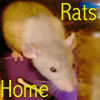
General Care
Personality/Habits
Lifespan
Nail & Teeth trimming
Baths
Introduction/Fighting
Quarantine

Colors & Markings
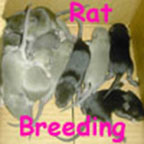
Sexing info
Pre-Breeding info
Pregnancy Info
Baby Info
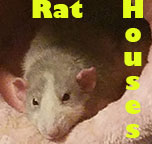
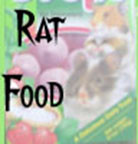

Health Tips
Eyes
Mycoplasma
Pneumonia
Temperature
Bugs
Veterinary Care
Abscesses & Tumors
Bumblefoot
Sprained ankles/Torn toenails
Wounds
Degloving/Tail injury
Aggression
Ears
Megacolon
Barbering
Old Age
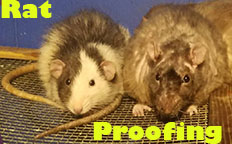
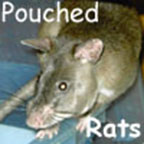

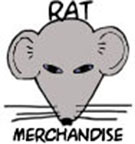



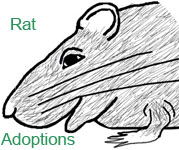
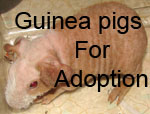


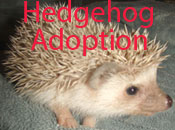
Please click on a picture to take you to each page
80stoysale.com HOME

12/02-2/15/10 7 years old.
There are two types of African Pouched rats.
They are very similar to each other and are mistakenly confused for each other all the time.
Emin's Pouched rat (Scientific name: Cricetomys Emini)
& Gambian pouched rats (Scientific name: Cricetomys Gambianus.)
Both types of Pouched rats originate from Africa and were imported to the United states at or around the same time for the Pet trade.
Nobody seemed to notice the differences between the two species of rats and called them all "Gambian's."
Other names for the Pouched rats include:
Pouched African rats, African rats, Pouched Rats & Giant Rats.
Pouched rat's have cheek pouches they can fill up with food and other finds. (Much like Chipmunks, Squirrels & Hamsters.)
Emin's Pouched rats are very good climbers and are very sturdy on their feet.
Gambian's are said not to be very good climbers.
Emin's have a white/tan under belly, while Gambian's do not have this, Gambian's are all one color.
Gambian's are quite a bit longer in length the Emin's rats.
Emin's rats have smoother hair than Gambian's.
Gambian's tend to have a fatter more plump face, while the Emin's face is much more slender.

Gambian rats can grow up to 3 feet long with their tail making up about half the size.
Emin's rats grow to about 2 1/2 feet long with their tail making up about half the size.
Both the Emin's & the Gambian rats are born with an all white tail, over a few weeks time the tail will get darker in color and/or dirty turning black.
The pouched rats clean the tip 3 to 4 inches of their tail making a black with a white tip tail.
Looking for the rats white tail end is known for determining that they are indeed Pouched rats
Gambians tend to weight 1-5 pounds.
Emin's tend to weight 1-4 pounds.
The Pouched rats only come in Agouti -"wild" hair colors such as Brown, black & gray.
Emin's sometimes have a slight reddish tint to their hair as well.
Pouched rats have been known to get along with regular rats but they will need to be introduced slowly and with reassurance that the other is alright to be there.
The regular rats enjoy hiding under the Pouched rat, as the pouched rats stand at a slant and the other rats easily fit under them.
If females are housed together and one is pregnant it is best to separate them, as the non mother female may feel threatened and injure or kill the babies as she will see them as competition.
If you have a set time to bring them out they will likely be at the cage door waiting for you to let them out.
They have very long tongues and large mouths.
(since bedding, cage mates and food may change)
However Pouched rats are very hard to hang on to, so the best way to give them a bath is to put them in a dry shower or tub and than use the sprayer to spray them off.
It is doubtful you will be able to soap them up as they are not fond of being held.
Giving them a good rinse will help loosen the dander and allow them to groom it off themselves at a later time.
Pouched rats can't see very well during the daylight.

Plastic igloo houses tend to work the best as Pouched ratties have very sharp teeth and love to chew on things.
They tend to chew more when they are under 2 years old.
Cardboard boxes work as houses also, althoon occasion the rats will make a game out of chewing them to shreds.
Covering Cardboard boxes with clear shipping tape will allow you to wipe the surface clean a few times and slow down the rattie chewing.
*I use Cardboard boxes for Stormy as she loves toys and sticks and small little stuffed animals that she insists on bringing into her house with her.
The igloo was just to cramped with her and all her toys inside!
I use a cardboard box which i cover the inside bottom with clear shipping tape and close up the box and cover the top with tape as well and cut out two doors, one on opposite sides of the box.
I than fill her box with her toys and sticks and shredded newspaper and an old shirt blanket for her to cuddle with.
The boxes last 2-3 weeks on average.
These noises are also referred to as churbling. (Mine makes these noises when trying to get under a closed door.)
It can also cause excessive sneezing when cage cleaning. I refer to the dust as "Rat dust."
The "dust" is created by the rat urinating on food and sleeping in it and occurs naturally on their skin which in turn when they bath themselves will fall onto the bedding.
The "Rat dust" or dirty rat nails scratching you can on occasion irritate your skin causing your skin to be red and itchy.
Washing with soap and water and putting on lotion can help the irritation disappear.
Pouched rats are very good about picking a certain spot in their cage as a toilet area.
*When Stormy goes back to her house when she is all done playing she will push her blankets and bedding into the doorway of her house to block off the door & the light.
*I occasionally find Stormy's whiskers when cleaning her cage, i collect the discarded whiskers and keep them in a scrapbook.
Trimming may be difficult or impossible.
Adding a rock in the cage, so they can stand and walk over it will help file their nails.
*Stormy has made her rock, her designated spot to sit and go to the bathroom behind.
They can chew through any size wire large or small, Rats do not have nerves in their teeth so they do not feel the electricity unless it comes in contact with their skin.
Pouched rats teeth and Jaws are very powerful, you do not want to get bit by one of them.
Always handle Pouched rats with caution.
*Stormy got curious once and fell into the toilet - she was very shocked! haha
Beware they are very strong, a good grip on the leash is necessary.
The Leash will need to be very tight fitting and need to be tested indoors to make sure the rat can not escape or chew through the harness.
It may take some time before you can find a leash or harness that your rat can not get out of.
*Stormy when she first wakes up has sleep/sand on her eyes keeping her eyes half closed, until she fully wakes up and cleans herself.
Food and water should be available to your rats at all times.
Food dishes are optional for these rats, as they have a tendency to drag the food dish into their house.
You can use a dish if you wish or you can put a handful of food in the corner of the cage.
Do not use thin plastic water bottles!
These giant rats will chew through thin plastic water bottles within seconds!.
These rats require heavy duty hard plastic or glass water bottles that they can not chew through.
The hard plastic water bottles are sometimes located in the Bird section of the pet stores.
Emin's tend to have 3-4 drinking sessions of water a day, typically drinking for 5-7 minutes filling up with plenty of water.
Rats do not have white teeth. They have orange teeth. Orange teeth are a good sign of Health.
However, if you feed your rat lots of snacks, or "people food", it won't take long before their teeth turn a dark orange which isn't healthy.
Pouched rats should be fed a mixture of Rodent blocks and a seed mixture of food.
These rats enjoy chewing on small dog bones and wood.
They like chewing on wood with some green still left in it, over dried wood.
Some store bought treats Pouched rats enjoy are: Yogurt drops, Raviolios, Cheese wedges & Banana chip treats.
Human foods Pouched rats also enjoy are: Spaghetti noodles, Frozen or cooked vegetables such as Peas or corn, bread, cereal, applesauce, yogurt, bananas and other pastas.
Pouched rats grow to be quite large, 3 feet at the largest with tail, so it is important to have a cage at least 3 1/2 feet in length.
Having a large cage is important, for Pouched rats cage length is more important and necessary than cage height.
Both aquariums and wire cages will work, but aquariums are not highly recommended.
Aquariums are not as well ventilated as wire cages.
Make sure the aquarium cover is sturdy and strong enough so they can not chew through it & make sure it is well ventilated material.
In Aquariums it can be quite difficult to attach toys and hammocks.
Aquariums are usually made of glass, so when cleaning and transporting the cages their is always a risk of the cage getting cracked or broken.
Cages with wire sides and plastic bottoms tend to work quite well.
They are well ventilated, and you can attach toys, hammocks, different levels, stairs etc. to the sides to make their house more entertaining.
Wire bottom cages do not work well with these rats, as their feet can get stuck, wire is uncomfortable to sleep on.
These rats also walk at a slant, so they put a bit of pressure on their back legs, and walking on a wire bottom cage can cause medical issues for the rats spine, and feet.
Covering wire flooring with plastic, tile, vinyl or another floor covering will prevent foot injuries.
In the wild Pouched rats live in Crevices and holes in the ground.
They will use holes left by other animals or will dig new ones. They close off their holes with leaves and plants.
Sometimes their holes will have several different chambers for food, bathroom and sleeping. areas

One way to avoid bugs in the bedding is to put the bedding in the freezer for at least 2 days.
No need to worry about poisonous inks as almost all newspaper these days use soy ink which is safe and non toxic.
Use only dull printed newspaper, not shiny glossy paper.
The shredded paper on top will help soak up urine and give the rats material to build nests with.
Blankets:
Fleece blankets are recommended as they have no strings or stitching your rats nails or toes could get caught on.
You can buy a blanket and cut it up or buy bulk fabric from the fabric store.
When using cloth towels make sure there are no loose strings or large holes in them that they can get caught on or in.
Blankets, scarves, & old clothing also works well for rat blankets. (Remove zippers and buttons if the clothing has any.)
Paper towels & Napkins also make good bedding and nesting material. -Especially for Pregnant females.
Training rats with a spray water bottle works well.
*When we let Stormy out to play she insists on trying to chew under and around our basement door which we keep closed so she won't get down there.
(Since once she got down there and crawled up into the ceiling panels and would not come down for 4-5 hours!)
When she starts chewing we spray her with water from a water spray bottle, it usually takes three sprays before she learns to leave the door alone.
She is slowly learning, when she gets too wet she gets upset and jumps back in her cage.
Rats do what they want to do so it can be fairly difficult to train them.
Another way to help teach your rat right from wrong is to use a firm "No" and spank them lightly on the rump. (Lightly! DO NOT hurt them!!)
If your rat has a strong personality and does not listen well, it may be impossible to train them, it's just like with humans, sometimes they just don't listen.
Animals need to be trained continually, which may require you to remind them what to do and not to do several times.
If you teach your rat not to go in a certain area and then later on it becomes acceptable. for them to go in that area, they will get confused and have difficulty learning.

The Pouched Rat is sexually mature at about five months old.
Breeding these rats is not recommended until they are 8 months to a year old.
When Female rats are in heat, they tend to stick their behinds up in the air in front of the male rats.
Pouched rats are pregnant for 27-36 days.
Most rats have 1 to 5 babies.
Babies do not open their eyes until they are 3 weeks old.
The babies stay with their mother in the wild usually until they are seven to eight weeks old.
In captivity the babies can be weaned anytime after 6 weeks of age.
Pouched rats can not breed with domestic rats, as they are different species.
Stormy was born at a breeder's location in Iowa December of 2002 and sold to another breeder in MN, who i acquired her from in February of 2003.
She was at first very timid and scared and chewed through many water bottles and enjoyed chewing her cardboard houses and igloos to shreds daily.
Ater a few months we bought her a new much larger cage and she started getting more comfortable.
When i bought Stormy i was told she was a Gambian rat and believed she was for over 4 years!
Then one day with much research and dispute i found she is indeed a Emin's pouched rat.
I got Stormy just a few short months before the Monkeypox/Ban on African imported rodents went into effect in the U.S.
The USDA and the FDA had to come to the locations which she was housed at and were given the all clear.
Stormy got along with my other pet rats, especially the males. The boys loved to chase her around and hide under her.
The female rats tended to try to pick on her and they would squeak at each other through the cage bars.
For some reason my hairless rats have always loved Stormy, they loved to sit outside her cage trying to get her attention to wake up and come out and play.
One of my boys, boomer loved to try to mount her which was pretty humorous as she was so much larger he basically would end up riding her back for a few inches and then fall off.
Stormy had very big teeth and has chewed through many of wires and other valuables.
She even chewed her way out of her cage one time, chewing through the plastic bottom cage side and got into the basement ceiling and tried to make herself right at home up there. She did this on a day when it was 95 degrees and extremly hot and humid, i was so worried she would overheat, i was also worried about all the wires that may be in the ceiling! I started ripping down ceiling panels and with a couple of us surrounding her managed to get her out after about an hour.
Stormy loved to climb up couches, chairs, beds, doors, closets and windows.
One time she climbed up the window frame and the window wasn't latched quite right and she fell out the window!
Panicing i rushed outside and called her name and she ran right up and hopped on my shoulder, Thank goodness! I think she was a bit scared by her weird new surroundings outdoors.
Stormy even chewed up one of my couches, chewing in between the cushions frantically making, many holes to go down below and hide. I couldn't stop her from eating that couch, she was determined and has big teeth, so after many, many attempts to stop her i just gave in and let her destroy it.
Stormy had an urgency for some reason to try to get downstairs of the house, i would close the door and she would run over frantically chewing, ripping up carpet and chewing on the door frame and wood. I put metal on the bottom of the door because she chewed so much carpet in front of it that she could sneak under!
I trained her as best i could, she knew her name and i used a water bottle to spray her when she was bad. But that only worked to some extent, i would spray her and she would run off only to run in a circle and come right back, sometimes i sprayed her so much she was sopping wet, but for some reason couches and the basement door were just things she had to get into!
Stormy didn't enjoy being held to much but got more tolerant as she got older.
She was quite hard to handle for holding but was a great shoulder rider and enjoyed that very much -but watch your neck for those sharp nail scratches!
Stormy absolutly loved vegetables, especially frozen peas and corn.
I would also give her pasta from time to time but she didn't like the sauce she wanted her noodles plain.
10/7/04 Stormy had Surgery for an Ear Hematoma. Her ear swelled up like a balloon and she needed to have the ear cut in two places and sewn flat to heal up.
I think what had happened was when climbing up onto the closet shelves she pinched her ear into between the shelf and the wall.
Trying to give a Pouched rat medicine is extremely difficult so i would drip the medicine onto her neck or cheek and she would then groom it off. Occasionally i would drop the medicine on a cookie crumb as well to get her to take her medicine.
If you think giving a pouched rat medicine is hard, try removing stitches from her ear. They were so small it was very hard to get her to hold still. I removed them myself because the Vet had to sedate her to look at her for pre op and surgery because she was so crazy and rambunctious and i didn't want her to have to be needlessly drugged again not to mention the stressful car ride in a carrier she probably would have chewed out of!
She recovered from surgery very well, but her ear was never quite the same and was then wrinkly.
At 4 years old Stormy was doing fantastic, she slowed down a little bit with age which i appreciated as it was a little easier to keep track of her.
Stormy enjoyed running crazily throughout the entire house and trying persistently to get under the basement door.
The easiest method of trying to keep track of her was to get out one of my regular boys and have them chase/follow her around.
Stormy was quite a bit faster than them so they did tend to loose her trail every now and than but they never gave up the search to find her again.
At 6 years old Stormy starting having a bit of hip trouble, she would slip a little bit and her hips started to give out at times. This limited her climbing and also slowed her down a bit, making her a bit easier to catch.
As she aged she let me cuddle and pet her alot more then she did in her younger years.
She loved bananas, pasta and yogurt drops!
Stormy made it to her 7th birthday and shortly after started declining in health, she began to sleep almost all of the time, rarely wanting to come out and exercise.
Stormy born 12/2002 died 2/15/2010 of old age.
I brought Stormy's body to a taxidermist to have her stuffed and now have her back!
The taxidermy cost more then 3 times as much as i paid for her originally.
Pouched rats are so rare and she was the only one i know of left in the U.S. (as a pet) i felt having her Taxidermied would also offer a great speciman for others to looks at and enjoy. I have had many museums and inquiries about wanting her body, but she was so special and important to me i would like to keep her with me forever, she was my daughter. I may consider bringing her to local rat shows or exhibits.
Here are some pictures of Stormy taxidermied. I have a plexi-glass case/cover i keep her in to prevent bugs and dust from getting to her.




Stormy peeking over the side of her cage.

Stormy standing peeking over the side of her cage.

Stormy on a pillow, on a shoulder, in a rat bed with Trip Monkey watching her, and being a bad girl chewing on the carpet.

Isn't she pretty?

Stormy exploring the kitchen, leaving her cage, and on the kitchen table.

Stormy hanging out on the bed.

Stormy's on the bed again!

Stormy with Shadow & Stormy with Ashes.

Stormy hanging out with Ashes.

Stormy peeking out of her igloo with her cheeks full.

Stormy peeking out of her cage with her cheek pouches filled.

Stormy sitting on a shoulder, showing her teeth, smiling.

Stormy running with her cheeks full.

Stormy holding her water bottle.

Stormy on the bed.

Stormy running across the couch.

Stormy licking the wall!

Stormy, Peaking at the other rats.

Stormy being a crazy rat, running all over the house.

Stormy on the top of the closet drinking her water.

Stormy.

Stormy.

Stormy.

Stormy.

Stormy.

Stormy.

Stormy.

Stormy.

At around 6 years old, she jumped in to visit the Guinea pigs and got a nibble on her tail and began having a little hip trouble every now and then but overall she was still doing great.
Stormy mellowed a lot with age and became much more tolerant of being held.
Stormy, look at those big cheeks!.

Stormy refilling her cheeks.

Stormy out exloring.

In 2003 the FDA and USDA banned the import and export of several African species due to the Monkey pox outbreak.
Pouched rats were among a few of the animals who became infected with the disease, the Monkey pox ultimately came from Prairie dogs and Wallbyes, but did infect a few Pouched rats who were housed at the same location.
They were banned for 5 years. As of Sept. 2008 the ban has been lifted as far as owning the Pouched rats, however it is still illegal to import them from Africa.
This is the catch, since pouched rats are not from here, there are none here to breed.